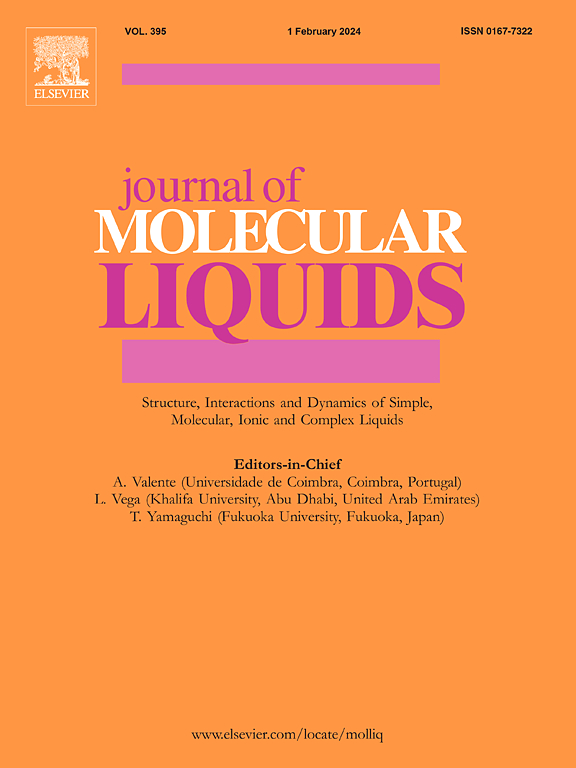2,5-二取代1,3,4-恶二唑对炎症介质和冠状病毒主要蛋白酶的双重抑制:一项计算研究
IF 5.3
2区 化学
Q2 CHEMISTRY, PHYSICAL
引用次数: 0
摘要
鉴于促炎蛋白环氧化酶-2 (COX-2)和白细胞介素-1β (IL-1β)在病毒感染中的重要作用以及1,3,4-恶二唑的高生物活性,本研究通过对COX-2、IL-1β和冠状病毒主要蛋白酶的分子对接,研究2,5-二取代1,3,4-恶二唑的双重抗炎和抗病毒潜力。分子对接和SAR分析发现化合物5m和5n与SARS-CoV-2、SARS-CoV-1、MERS-CoV和hCoV的COX-2、IL-1β和主要蛋白酶具有很强的亲和力。关键的相互作用包括与催化残基的疏水/静电结合,如COX-2中的Arg120和病毒蛋白酶中的His41-Cys145二偶体,这表明酶功能具有破坏性作用。SAR研究表明,R3取代(H >;我在;Ph值)增强抗炎活性,而独特的芳香环有助于选择性抑制病毒蛋白酶。分子动力学(MD)模拟证实了配体-蛋白相互作用的稳定性,其中5m诱导炎症蛋白的构象变化最多,并在病毒蛋白酶中引起显著的结构压缩。值得注意的是,化合物5m诱导MERS-CoV和hCoV主要蛋白酶的结构压缩,潜在地破坏了它们的酶促功能。虽然nirmatrelvir在SARS-CoV-2 Mpro中造成最大的压缩,但5 m表现出显著的结构效应,进一步验证了其抗病毒潜力。MM/PBSA和MD模拟显示,5m和5n是很有前途的抗炎和抗病毒药物,它们通过静电和范德华相互作用与COX-2和病毒蛋白酶结合。总的来说,这项研究为开发2,5-二取代1,3,4-恶二唑作为创新的双功能治疗药物提供了坚实的基础。5m和5n的活性突出了它们作为下一代靶向炎症和病毒复制药物的潜力。本文章由计算机程序翻译,如有差异,请以英文原文为准。
Dual inhibition of inflammatory mediators and Coronaviridae main proteases by 2,5-disubstituted 1,3,4-oxadiazoles: a computational study
Given the critical role of pro-inflammatory proteins, cyclooxygenase-2 (COX-2) and Interleukin-1β (IL-1β), in viral infections and the high bioactivity of 1,3,4-oxadiazoles, this study investigates 2,5-disubstitutted 1,3,4-oxadiazoles via molecular docking against COX-2, IL-1β, and coronavirus main proteases to assess their dual anti-inflammatory and antiviral potential. Molecular docking and SAR analysis identified compounds 5 m and 5n as lead candidates with strong affinities for COX-2, IL-1β, and main proteases of SARS-CoV-2, SARS-CoV-1, MERS-CoV, and hCoV. Key interactions include hydrophobic/electrostatic binding with catalytic residues, such as Arg120 in COX-2 and the His41-Cys145 dyad in viral proteases, suggesting a disruptive effect on enzymatic functions. SAR studies reveal that R3 substitution (H > Me > Ph) enhances anti-inflammatory activity, while distinct aromatic rings contribute to selective inhibition of viral proteases. Molecular dynamics (MD) simulations confirmed the stability of ligand-protein interactions, with 5 m inducing the most conformational changes in inflammatory proteins and significant structural compression in viral proteases. Notably, compound 5 m induced structural compression in MERS-CoV and hCoV main proteases, potentially disrupting their enzymatic function. While nirmatrelvir caused the highest compression in SARS-CoV-2 Mpro, 5 m exhibited remarkable structural effects, further validating its antiviral potential. MM/PBSA and MD simulations highlight 5 m and 5n as promising anti-inflammatory and antiviral agents, with superior COX-2 and viral protease binding via electrostatic and van der Waals interactions. Overall, this study provides a strong foundation for developing 2,5-disubstituted 1,3,4-oxadiazoles as innovative, dual-function therapeutics. The promising activities of 5 m and 5n underscores their potential as next-generation drugs targeting inflammation and viral replication.
求助全文
通过发布文献求助,成功后即可免费获取论文全文。
去求助
来源期刊

Journal of Molecular Liquids
化学-物理:原子、分子和化学物理
CiteScore
10.30
自引率
16.70%
发文量
2597
审稿时长
78 days
期刊介绍:
The journal includes papers in the following areas:
– Simple organic liquids and mixtures
– Ionic liquids
– Surfactant solutions (including micelles and vesicles) and liquid interfaces
– Colloidal solutions and nanoparticles
– Thermotropic and lyotropic liquid crystals
– Ferrofluids
– Water, aqueous solutions and other hydrogen-bonded liquids
– Lubricants, polymer solutions and melts
– Molten metals and salts
– Phase transitions and critical phenomena in liquids and confined fluids
– Self assembly in complex liquids.– Biomolecules in solution
The emphasis is on the molecular (or microscopic) understanding of particular liquids or liquid systems, especially concerning structure, dynamics and intermolecular forces. The experimental techniques used may include:
– Conventional spectroscopy (mid-IR and far-IR, Raman, NMR, etc.)
– Non-linear optics and time resolved spectroscopy (psec, fsec, asec, ISRS, etc.)
– Light scattering (Rayleigh, Brillouin, PCS, etc.)
– Dielectric relaxation
– X-ray and neutron scattering and diffraction.
Experimental studies, computer simulations (MD or MC) and analytical theory will be considered for publication; papers just reporting experimental results that do not contribute to the understanding of the fundamentals of molecular and ionic liquids will not be accepted. Only papers of a non-routine nature and advancing the field will be considered for publication.
 求助内容:
求助内容: 应助结果提醒方式:
应助结果提醒方式:


